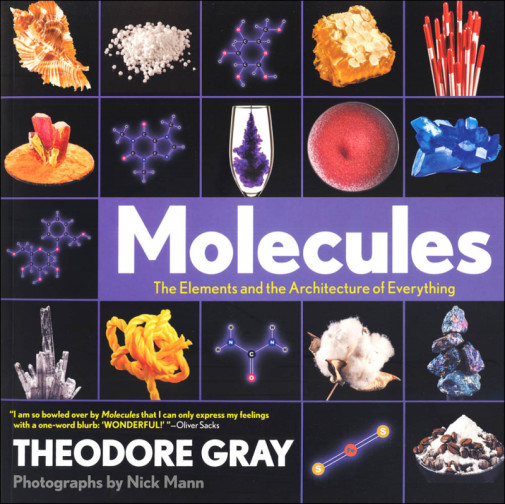We use cookies to make your experience better. To comply with the new e-Privacy directive, we need to ask for your consent to set the cookies. Learn more.
Molecules: The Elements and the Architecture of Everything
Another beautiful book by Theodore Gray and Nick Mann - this softcover book takes you on a photo journey into the world of molecules! Atoms combine to form molecules: they combine in different ways, and you get different materials. Because there are literally thousands of molecule combinations, this 240-page book (heavyweight glossy paper) is just a small sampling of what we encounter daily. Gray begins by explaining molecules and compounds and jumps right into different categories of molecules. Every chapter begins with an explanation of the type of molecules shown and how the atoms work together to form them. Full color photos are shown of molecules within the category, the name of the material, and an illustration of the molecular structure. I don't think of myself as a science nerd, but I find this fascinating. This is an explanation of the world we can't see without a microscope amazing and complex! If you want to see how things are formed, from acetaminophen to Zylon, you will love this book! ~ Donna
Molecules is the second book in the million-copy bestselling Elements trilogy. In Molecules, Theodore Gray takes the next step in the story that began with the periodic table in his best-selling book, The Elements: A Visual Exploration of Every Known Atom in the Universe (2015) and culminated with the publication of Reactions: An Illustrated Exploration of Elements, Molecules, and Change in the Universe (2017). Here, he explores through fascinating stories and trademark stunning photography the most interesting, essential, useful, and beautiful of the millions of chemical structures that make up every material in the world.
Gray begins with an explanation of how atoms bond to form molecules and compounds, as well as the difference between organic and inorganic chemistry. He then goes on to explore the vast array of materials molecules can create, including: soaps and solvents; goops and oils; rocks and ores; ropes and fibers; painkillers and dangerous drugs; sweeteners; perfumes and stink bombs; colors and pigments; and controversial compounds including asbestos, CFCs, and thimerosal.
Big, gorgeous photographs, as well as diagrams of the compounds and their chemical bonds, rendered with never before seen beauty, fill the pages and capture molecules in their various states.
It's the perfect book for his loyal fans who've been eager for more and for anyone fascinated with the mysteries of the material world.
Homeschool Chemistry Curriculum, Workbooks, Lab Materials, Kits, Games, and Chemistry Lab Supplies
| Product Format: | Paperback |
|---|---|
| Brand: | Black Dog and Leaventhal |
| Author: | Theodore Gray |
| Grades: | 7-AD |
| ISBN: | 9780316480581 |
| Length in Inches: | 10.25 |
| Width in Inches: | 10.375 |
| Height in Inches: | 0.875 |
| Weight in Pounds: | 3 |

